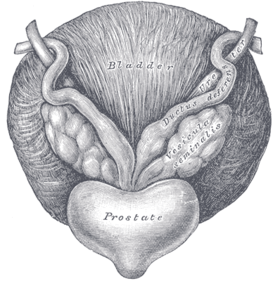
Back استئصال البروستات Arabic Prostatectomia Catalan Prostatektomie German پروستاتبرداری Persian Prostatectomie French Prostatectomia Italian 전립샘절제술 Korean Prostatectomia Portuguese Простатэктомия Russian Prostatectomy SIMPLE
| Prostatectomy | |
|---|---|
 Anatomy of the prostate | |
| ICD-9-CM | 60.2–60.6 |
| MeSH | D011468 |
Prostatectomy (from the Greek προστάτης prostátēs, "prostate" and ἐκτομή ektomē, "excision") is the surgical removal of all or part of the prostate gland. This operation is done for benign conditions that cause urinary retention, as well as for prostate cancer and for other cancers of the pelvis.
There are two main types of prostatectomies. A simple prostatectomy (also known as a subtotal prostatectomy) involves the removal of only part of the prostate. Surgeons typically carry out simple prostatectomies only for benign conditions.[1] A radical prostatectomy, the removal of the entire prostate gland, the seminal vesicles and the vas deferens, is performed for cancer.[2]
There are multiple ways the operation can be done: with open surgery (via a large incision through the lower abdomen), laparoscopically with the help of a robot (a type of minimally invasive surgery), through the urethra or through the perineum.
By laser prostatectomy (HoLEP - Holmium laser enucleation of the prostate), a laser is used to cut and remove the excess prostate tissue that is blocking the urethra. Another instrument is then used to cut the prostate tissue into small pieces that are easily removed. HoLEP can be an option for men who have a severely enlarged prostate.[3]
Other terms that can be used to describe a prostatectomy include:
- Nerve-sparing: the blood vessels and nerves that promote penile erections are left behind in the body and not taken out with the prostate.
- Limited pelvic lymph node dissection: the lymph nodes surrounding and close to the prostate are taken out (typically the area defined by external iliac vein anteriorly, the obturator nerve posteriorly, the origin of the internal iliac artery proximally, Cooper's ligament distally, the bladder medially and the pelvic side wall laterally).[4]
- Extended pelvic lymph node dissection (PLND): lymph nodes farther away from the prostate are taken out also (typically the area defined in a limited PLND with the posterior boundary as the floor of the pelvis).[4]
- ^ Khera, Mohit (October 23, 2013). "Simple Prostatectomy". Medscape. Retrieved November 8, 2014.
- ^ McAninch, Jack W. (2008). Smith and Tanagho's General Urology. New York: McGraw Hill Medical. p. 368. ISBN 978-0-07-162497-8.
- ^ "HoLEP Procedure: Holmium Laser Enucleation of the Prostate". www.hopkinsmedicine.org. 2023-08-02. Retrieved 2024-03-04.
- ^ a b Wider, Jeff A. (2014). Pocket Guide to Urology. J. Wieder Medical. pp. 141–142. ISBN 978-0-9672845-6-9.
© MMXXIII Rich X Search. We shall prevail. All rights reserved. Rich X Search